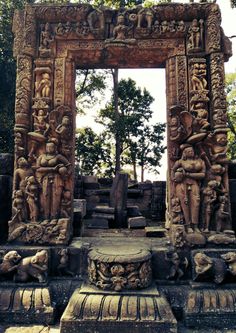
Deepadih, located 72 kms. from
Ambikapur on Kusmi road leading to Jharkhand, in tribal area, is an important
site, full of archaeological wealth. This ancient beautiful temple city was
situated on the confluence of rivers Kanhar and Golfulla, the tributaries of
river Rehand. This site is famous for its natural beauty. The literal meaning
of Deepadih is habitation on high mound. The ruined structures and old remains
scattered in the radius of about 1 km. indicate that Deepadih was an important
cultural centre which flourished from 7th-13th cent. A.D. Debris-clearance
operation was conducted by the State Department of Archaeology many temple
sites and valuable sculptures were unearthed during this operation. This sites
is now identified as an important archaeological site and tourist centre.
Historical background of this site
is not clear. The only one stone inscription, found here, is defaced and is not
readable. According to local myth Samat Raja was the ruler of Samat-Sarna.
Tangi Nath a ruler of Distt. Palamu, Bihar invaded Samat Sarna. Samat Raja was
defeated and killed while his queens jumped in baodi and scarified their lives.
Most possibly this incident indicates the invasion of rulers of Kalchuris of Tripuri
Seat.
Temples of Samat Sarna group contain
special importance. In this group there is a remains of Large Shiva Temple
facing the east direction. A stone-built door is richly ornamented and very
artistic. There is a depiction of river goddesses, Ganga and Yamuna, including
decorative motives seated Gaja Lakshmi
is shown on Lalatalimba Images of Kartikeya, Sixteen-armed Vishnu Varaha,
Mahishasur-mardini, Bhairav, Ganesh and of Gauri are on display along with decorated
pillars in Mandapa.
Remains of Chamunda temple are
square in shape where the image of Chamunda was installed. Near this temple in
another Shiva temple images of Shiva Pratihara and river goddesses on
door-jambs have been noticed. On the eastern portion there is a platform of
Shiva-Panchaytan-temple built by the Somavanshi ruler indicative
of art style
of that period.
Apart from this in this complex
there are plenty of architectural remains built in the period of Pala-Vansha of
Bengal and Kalchuris of Tripuri. In the northern portion of the complex there
is a stepped square Baodi. Actually, the holy water of this Baodi was used for
abhiseka purposes
Borja Tila Temple group of the
ruined temples is a second groups. Remains of big Sun temple is a main
structure and the remains of residential
monastaries are also visible. In front of temples of Borja group a third
group of temples is located near old tank called Rani Pokhar (ancient
Rani-Pushkar). Small-sized four temples were built here but only platform is
available. Rani-Pokhar is a historical tank in rectangular shape. Ancient ghat
or pachari were made of stones in all directions.
On the way from Deepadih to Uraon
Tola, near school-building fourth group of temples is found where three ruined
temples exist. Among them huge Jalahari built in stone was installed. There is
a depiction of images of god and goddesses, erotic couples, Nayikayen and other
decorative motives on standing pillars.
Another important Shiva temple of this group is situated in Uraon
Tola. This temple contains sanctum, antaral and mandapa. Adhisthan of the
temple is very artistic. Decoration of serpent-creeper is in the tradition of
Somavanshi art. many sculptures and decorated architectural pieces are
displayed here.
Chaila Hill is also an important place,
worth a visit, 6 km in south of the village Deepadih. The word chaila means
chiseling. Architectural slabs and stone were chiseling here and sent to the
Deepadih. In one rock there is an inscription Oni namo Vishvakarmay. It
indicates that after prayer of God Vishva-Karma the artists on the sculptor
started the Chiselled in mass scale for temple building purpose.
After keen observation of the
remains of Deepadih, it is supposed that this area was under rule of Somvanshi
kings of South-Kosal in 7th-8th cent. A.D. In 1st phase in their regime few
temples were made. After that Pala rulers and Kalchuris of Tripuri seat were
also ruled this region and temples made in plenty.
In connection with reconstruction of
cultural history of Chhattisgarh the art, architecture iconography and
inscriptions found at Deepadih contain
special importance. The
loose and detached objects and
antiquities were collected and kept in display in local Sculpture-Shed. Among
them the sculptures of Bhairava, Shiva-attendants, Brahma, Uma-Maheshvara,
Mother Goddess, Ganesha, Vishnu, Surya, Hari-Hara, Chamunda, Shiva holding
parashu, Kartikeya are remarkable and contain balanced measurement, grace and
gesture.
Seeing the archaeological wealth and
natural scenery visitors become and roamed around in a particular period. The climate of this
site is healthy and environment is also good. For making eternal contacts with
Cultutral Heritage of this site and for promotion of tourism this site is an
ideal place which can be developed in this tribal belt. This important site is
declared a protected site. The Government is taking steps for conservation,
development, security and beautification of this site seriously.